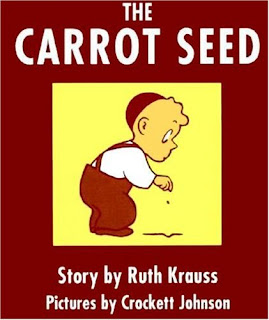Mac and Steve didn't have any food to share, but instead some practical lessons on how you can create better picture books by reading classic picture books.
Steve: There's always a place for great picture books. I sent out a book last week that was a real throw back, one editor called it 'the love child of Maurice Sendak and Sandra Boynton.' Editors still love and look to the classics in picture books... I always try to stay away from trends.
Mac: Which brings us to Lesson Number One: Vampire Picture Books.
The slide show starts, all the gorgeous hand-lettering of the rules slides (which you can't see) done by Laura Park.
Lesson #1: Let the Illustrations Do Their Job
A masterpiece of storytelling with no words, GOODNIGHT GORILLA
A masterpiece of not overwriting the scene, THE STUPIDS STEP OUT
A masterpiece of leaving the whole joke to the art, THE CARROT SEED
Lesson #2: Understand the Picture Book's Conventions
The Page Turn (Mac thinks this is the most imporant aspect of plotting a picture book and here are some of his favorites)
HENRY'S AWFUL MISTAKE
THE MONSTER AT THE END OF THIS BOOK
Page layout formats, when repeated, create a visual rhythm for a book
(As an author, Mac especially enjoys writing wordless, two-page spreads.)
Good visual rhythm and suspenseful page turns in
MADELEINE
THE HAT (Mac hearts Tomi Ungerer!!!)
BILLY TWITTERS AND HIS BLUE WHALE PROBLEM
Lesson #3 The Writing Must Serve the Book
Pay a lot of attention to how YOU are going to write your book, not how Dr. Seuss would have written your book. Pick a tone and stick with it—will it be sweet? Or have an edge? If you do want to rhyme, Mac recommends Paul Fussell and Mary Oliver's great books on verse.
Some good examples of rhyme from Steve who says there's a logic to why they used rhyme and they read flawlessly:
BEAR SNORES ON
TIME FOR BED
GUESS AGAIN!
Steve: Read your work out loud to lots of people. People that have never heard it before. Like when the UPS guy comes by, read your story to him.
Mac: Don't read your story to the UPS guy, that's a horrible idea, he'll start losing all your packages if you do that.
Lesson #4, Lesson #5 I will save for conference goers alone to relish. But here's a shot of Steve and Mac being mobbed after their session:
And here's illustrator/writer Dan Santat, illustrator of Mac's OH NO!. That is his happy face.















This was brilliant - I took away loads. Thanks guys.
ReplyDelete